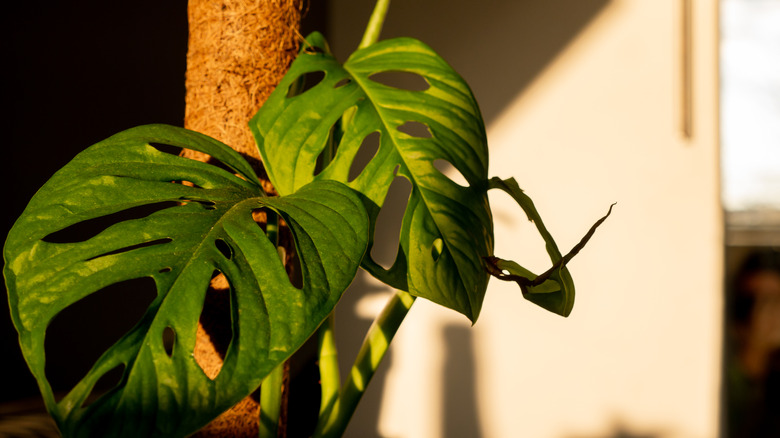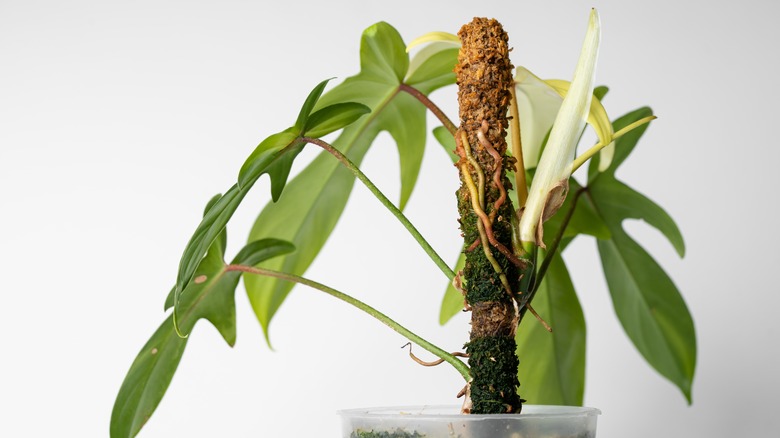What's A Moss Pole And Why Should You Add One To Your Houseplants?
Houseplant enthusiasts are often faced with a dilemma: How do you make a plant thrive in domestic conditions when it was meant to be growing out in the wild? Some people will go to great lengths to ensure their plants have the ideal temperature, humidity, watering schedule, and sunlight to mimic their natural environment, but plants are more symbiotic than we realize. Some literally depend on each other for the physical support they need to grow properly, especially trailing plants and epiphytes. One of the best ways to mimic a natural forest environment for your plants is by using a moss pole, a simple rod or stick covered in sphagnum moss. Moss poles can be short or tall and either left bare or covered in a net to provide more grip for searching vines.
When stuck into the soil of a potted plant, a moss pole helps vining plants grow upwards and encourages them to develop more roots and denser foliage. If you've noticed that your philodendron, pothos, or monstera's growth has slowed or the leaves are starting to look weak, dry, and pale, you may want to invest in a sphagnum moss pole. Here's what you need to know about the purpose and benefits of a moss pole and how you can craft your own in a few simple steps.
Purpose and benefits of a moss pole
In nature, some plants prefer to grow in the nooks and crannies of trees and shrubs, where they can absorb the water and micronutrients that collect there and use the support to reach up for sunlight. A moss pole isn't a necessity for most plants, but it can provide essential support that helps your vining and trailing plants thrive as they would outdoors. Species that would do well to have a moss pole include monstera, pothos, philodendrons, ivies, arrowhead plants, and epiphytes like air plants.
As these plants grow, they send out tendrils or aerial roots that seek out surfaces to cling to. If a plant can find a moss pole, it will also use its micronutrients to create more large, green, and healthy leaves. Even for non-climbing plants, such as ferns, a moss pole can be helpful to retain moisture and raise the humidity near the plant. However, it's important to pay close attention to your moss pole, should you choose to have one. While they can be helpful for retaining water, too much moisture creates a perfect breeding ground for fungus and mold. Keep a close eye out for signs of mold, and remove rotten and decaying moss poles from your home as quickly as possible to avoid harming your plant and worsening air quality.
How to make a moss pole
While moss poles aren't typically very expensive, you can save a few dollars and a trip to the gardening store by creating your own. As a safety precaution, you should always wear gloves when working with sphagnum moss. While rare, it is possible to contract an infection known as sporotrichosis from a fungus that can live in sphagnum moss (via the Centers for Disease Control and Prevention). Alternatively, you can use coco coir, but the pole won't be able to retain as much moisture.
To make your own moss pole, you'll need a wooden dowel, PVC pipe, a long stake, or something similar to use as your pole. Soak a generous amount of sphagnum moss in a container of water for about 20 minutes, then gently scoop it out and squeeze to remove any excess water. Pack the moss around your pole and wrap thin wire, fishing line, or twine to secure it, leaving the bottom few inches bare. You may need to apply a few layers of moss this way. Sink the bare end of the pole into your soil, then use more thread or wire to loosely tie your plant to the pole; you only need to provide a guide until the tendrils and aerial roots can find their way into the sphagnum moss. Mist your moss pole a few times weekly with water to encourage the roots to adhere to it and keep growing.


